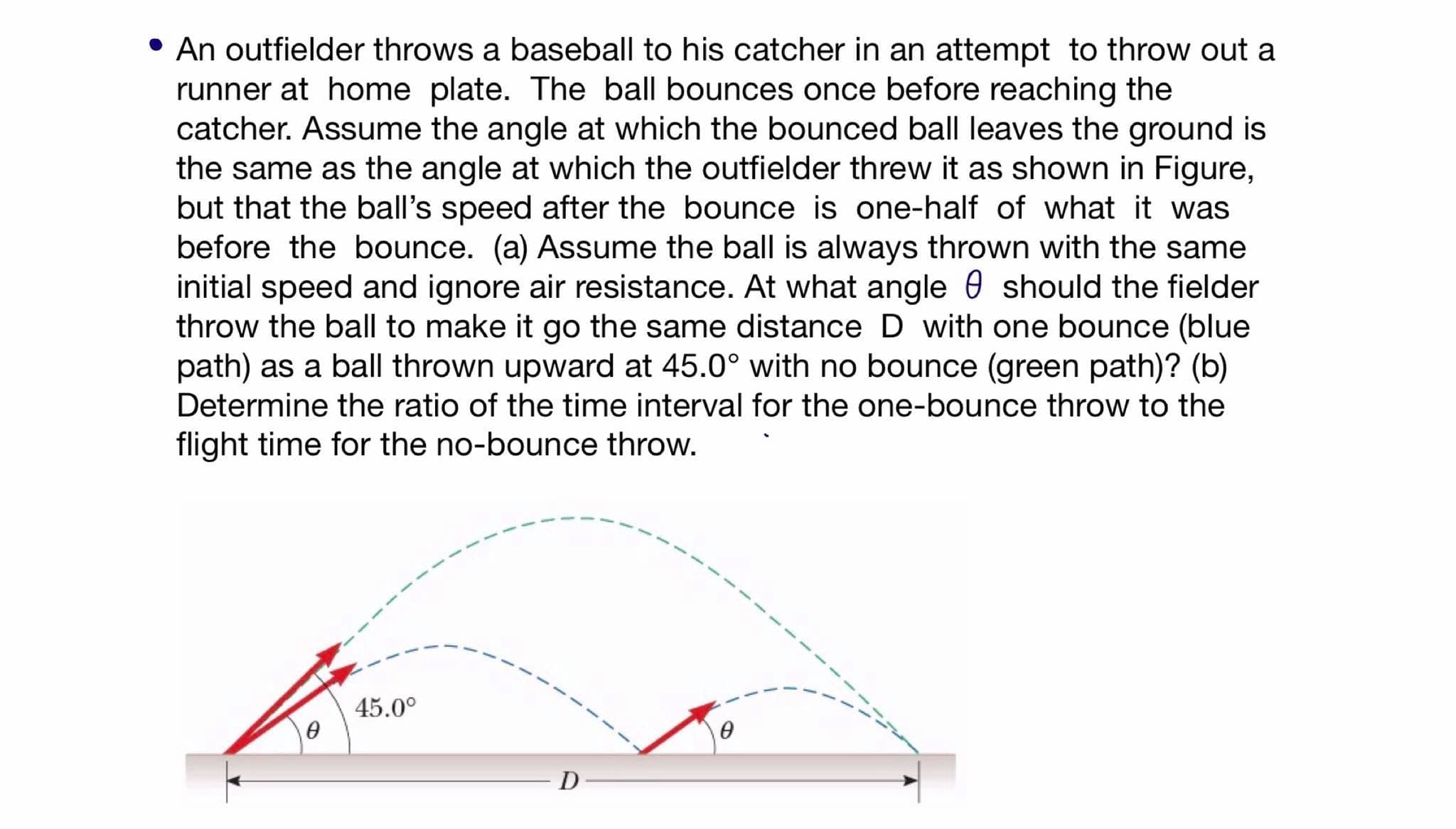An outfielder throws a baseball to his catcher in an attempt to throw out a runner at home plate. The ball bounces once before reaching the catcher. Assume the angle at which the bounced ball leaves the ground is the same as the angle at which the outfielder threw it as shown in Figure, but that the ball's speed after the bounce is one-half of what it was before the bounce. (a) Assume the ball is always thrown with the same initial speed and ignore air resistance. At what angle 0 should the fielder throw the ball to make it go the same distance D with one bounce (blue path) as a ball thrown upward at 45.0° with no bounce (green path)? (b)
An outfielder throws a baseball to his catcher in an attempt to throw out a runner at home plate. The ball bounces once before reaching the catcher. Assume the angle at which the bounced ball leaves the ground is the same as the angle at which the outfielder threw it as shown in Figure, but that the ball's speed after the bounce is one-half of what it was before the bounce. (a) Assume the ball is always thrown with the same initial speed and ignore air resistance. At what angle 0 should the fielder throw the ball to make it go the same distance D with one bounce (blue path) as a ball thrown upward at 45.0° with no bounce (green path)? (b)
University Physics Volume 1
18th Edition
ISBN:9781938168277
Author:William Moebs, Samuel J. Ling, Jeff Sanny
Publisher:William Moebs, Samuel J. Ling, Jeff Sanny
Chapter4: Motion In Two And Three Dimensions
Section: Chapter Questions
Problem 14CQ: If someone is riding in the back of a pickup thick and throws a softball straight backward, is it...
Related questions
Question
I need an answer of a and b, please show me how to do it in detail.
THANKYOU^^ (2D-MOTION)

Transcribed Image Text:An outfielder throws a baseball to his catcher in an attempt to throw out a
runner at home plate. The ball bounces once before reaching the
catcher. Assume the angle at which the bounced ball leaves the ground is
the same as the angle at which the outfielder threw it as shown in Figure,
but that the ball's speed after the bounce is one-half of what it was
before the bounce. (a) Assume the ball is always thrown with the same
initial speed and ignore air resistance. At what angle 0 should the fielder
throw the ball to make it go the same distance D with one bounce (blue
path) as a ball thrown upward at 45.0° with no bounce (green path)? (b)
Expert Solution
This question has been solved!
Explore an expertly crafted, step-by-step solution for a thorough understanding of key concepts.
This is a popular solution!
Trending now
This is a popular solution!
Step by step
Solved in 3 steps with 5 images

Knowledge Booster
Learn more about
Need a deep-dive on the concept behind this application? Look no further. Learn more about this topic, physics and related others by exploring similar questions and additional content below.Recommended textbooks for you

University Physics Volume 1
Physics
ISBN:
9781938168277
Author:
William Moebs, Samuel J. Ling, Jeff Sanny
Publisher:
OpenStax - Rice University

Classical Dynamics of Particles and Systems
Physics
ISBN:
9780534408961
Author:
Stephen T. Thornton, Jerry B. Marion
Publisher:
Cengage Learning

College Physics
Physics
ISBN:
9781938168000
Author:
Paul Peter Urone, Roger Hinrichs
Publisher:
OpenStax College

University Physics Volume 1
Physics
ISBN:
9781938168277
Author:
William Moebs, Samuel J. Ling, Jeff Sanny
Publisher:
OpenStax - Rice University

Classical Dynamics of Particles and Systems
Physics
ISBN:
9780534408961
Author:
Stephen T. Thornton, Jerry B. Marion
Publisher:
Cengage Learning

College Physics
Physics
ISBN:
9781938168000
Author:
Paul Peter Urone, Roger Hinrichs
Publisher:
OpenStax College